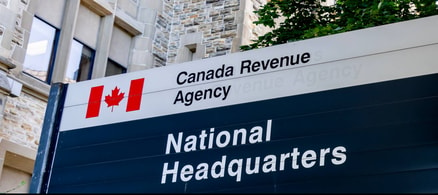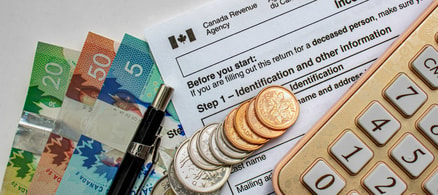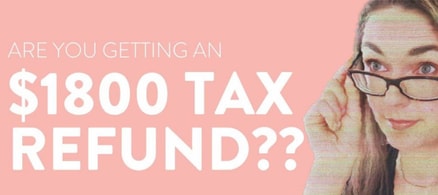What you should know before filing
If you made less than $30,000 on your side gig last year, you can breathe easy. Sure, you still have to pay income tax on the money you earned, but you don't need to worry about collecting (or paying) GST or HST to the Canada Revenue Agency.
However, if you made more than $30,000, you'll need to register with the CRA and then pay more taxes when you file. If you drive a taxi or work for a rideshare service, you'll need to register no matter how much you make.
Failure to do so will result in penalties from the CRA, such as being fined.
Signing up for a GST and HST number could be worth it — even if your business makes less than $30,000 — if your business generates a lot of expenses, says Jamie Golombek, managing director, tax and estate planning at CIBC.
Registering can allow you to recoup some of the GST/HST you paid, but some folks find it tedious and time consuming. It requires you to document your expenses and may not be worth it if you have a low income, or don’t have plans to grow your business.
“It's probably not worth registering for GST or HST, unless your expenses are in the thousands of dollars and you can recoup hundreds of dollars of GST or HST,” Golombek says.
Maximize Your Tax Refund with TurboTax Canada!
Simplify tax season with this user-friendly software. Get step-by-step guidance, maximize deductions, and file with confidence. Trusted by millions, TurboTax Canada ensures accuracy and peace of mind. Start your taxes today and get the refund you deserve
Get the tax refund you deserveExpenses you can claim
Business expenses can be deducted from your taxable income, lowering the amount you are responsible for.
The Canadian government lists some common items you can file as a business expense. They include:
- Rent
- Fuel costs
- Repairs
- Travel
A common mistake people make is being too aggressive on what they label as a business expense, Golombek says. This can also lead to an audit, and the expense may be rejected.
Consider your tax bracket
Depending on how much you make you’ll be placed in a tax bracket, which determines how much income tax you pay. When reporting your taxes, the income from your side hustle is combined with your main income. The combined amount will dictate what tax bracket you fall under.
Your federal tax bracket is determined by your total income, minus allowable deductions and exemptions.
Here are the tax brackets and income tax rate for the 2022 tax year:
- 15% for $50,197 or less
- 20.5% for $50,197 to $100,392
- 26% for $100,392 to $155,625
- 29% for $155,625 to $221,708
- 33% for more than 221,708
In addition to your federal income tax, your province and territory also charge income tax. The brackets might be different in your province or territory. For example, in Quebec, you get taxed 15% on the first $46,295; 20% on the next $46,285; 24% on the next $20,075; and 25.75% on the amount over $112,655.
In total, employees in Canada will be paying both their provincial and federal governments when reporting their income. Make sure you know which tax bracket you fall under as you file your tax return.
Grow Your Savings Effortlessly with Moka
Automate your savings with every purchase and watch your money multiply. Moka rounds up your transactions and invests the spare change. Start building wealth effortlessly today. Join thousands of Canadians embracing financial freedom with Moka
Sign up nowLowering your taxable income
If you're right on the border between brackets, it is possible to lower your taxable income to reach a lower tax rate. The most common way to do this is by contributing to a Registered Retirement Savings Plan. Contributing to your RRSP can reduce your taxable income, qualifying you for a lower tax bracket.
The maximum amount you can contribute is based on your income from the previous year, your deduction limit, plus any unused contribution room you haven't used in previous years. The deduction limit for the 2022 tax year is 18% of your income, up to a maximum of $29,210. For 2023 the deduction limit is 18% of your income, up to a maximum of $30,780. The limit is also affected by how much you’ve already contributed, as well as your employment status.
The good news is that there’s still a little bit of time to reduce your taxable income. For your 2022 taxes, you have until March 1, 2023 to add to your RRSP.
Consider charitable donations
Another option is to donate to a charity of your choice. Doing so will allow you to claim a charitable tax credit, which can also lower your taxable income.
Mark Blumberg, a charity and non-profit lawyer, encourages people to do their own research before making a donation. This includes making sure the charity is registered with the government and can provide a tax receipt. The receipt is proof that your donation is valid for income tax purposes. Otherwise, your donation will not count toward reducing your income tax. Some charities may also have a certain amount you must donate before getting a receipt.
"Canada is one of the countries with the most generous tax incentives for donations to charities, and they have to provide you with some accountability on how they spend your money including an annual public return filed with CRA," Blumberg says, warning some charities may not spend your money responsibly.
You may also want to consider giving to lesser-known charities, Blumberg says. Your donation can make more of a difference there, rather than a major charity that already receives millions in funding.
"BIPOC charities receive far less money than other charities, consider donating to them," Blumberg says.
Sponsored
Trade Smarter, Today
With CIBC Investor's Edge, kick-start your portfolio with 100 free trades and up to $4,500 cash back.







